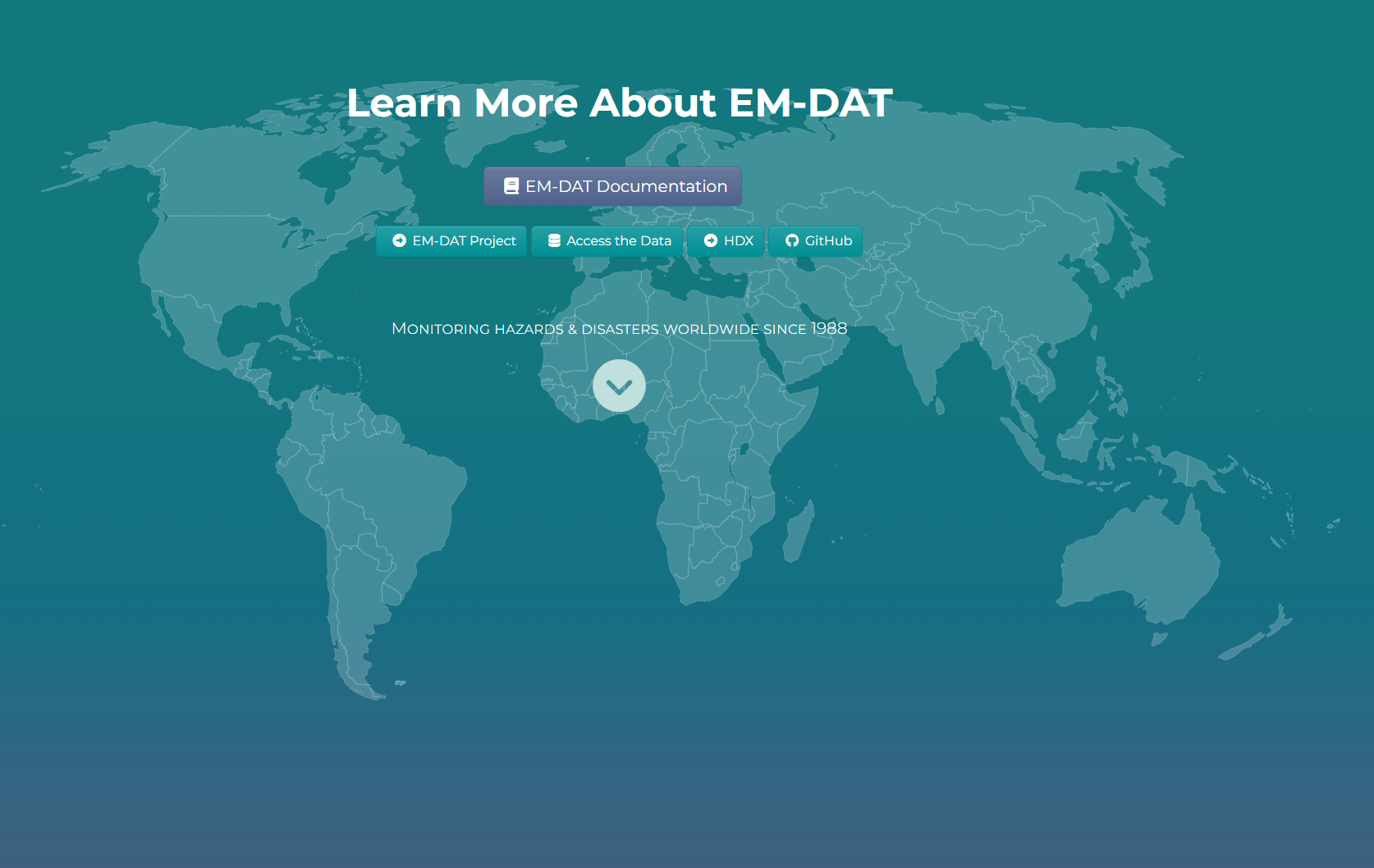EM-DAT (Emergency Events Database) is the world's most comprehensive disaster database, containing data on over 26,000 mass disasters worldwide from 1900 to the present, providing essential information on disaster occurrence, human and economic impacts for humanitarian action and disaster risk reduction.
Maintained by the Centre for Research on the Epidemiology of Disasters (CRED) at the University of Louvain (UCLouvain) and primarily sponsored by USAID, EM-DAT serves as the global reference for disaster statistics and trends, supporting evidence-based decision-making for disaster preparedness and risk reduction strategies.
Whether you're involved in humanitarian response, disaster risk assessment, climate research, or policy development, EM-DAT provides authoritative disaster data for understanding global disaster patterns and impacts.
1. Comprehensive Disaster Documentation
EM-DAT records major disasters globally with specific inclusion criteria:
Inclusion Criteria (at least one must be met):
- 10 or more fatalities
- 100 or more people affected
- Declaration of state of emergency
- Call for international assistance
Data Coverage:
- Over 26,000 disaster records since 1900
- Global coverage at country level
- Annual updates with recent disasters
- Historical depth for trend analysis
- Standardized data collection methodology
2. Hierarchical Disaster Classification
EM-DAT uses a systematic classification system for disaster types:
Natural Disasters (about 2/3 of all disasters):
Meteorological:
- >4,580 Storm events (hurricanes, typhoons, cyclones)
- >600 Extreme temperature events (heat waves, cold waves)
Hydrological:
- >5,750 Flood events (riverine, coastal, flash floods)
- >790 Landslide events
Climatological:
- >790 Drought events
- >450 Wildfire events
Geophysical:
- >1,570 Earthquake events
- >270 Volcanic activity events
Technological Disasters:
- Transport accidents
- Industrial accidents
- Miscellaneous accidents
3. Comprehensive Impact Metrics
EM-DAT records detailed impact information for each disaster:
Human Impact:
- Number of deaths and missing persons
- Number of injured people
- Number of affected people (requiring assistance)
- Number of homeless people
Economic Impact:
- Total economic losses (when available)
- Damage to infrastructure and property
- Agricultural losses
- Industry and service sector impacts
Response Metrics:
- International assistance received
- Emergency declarations and duration
- Evacuation numbers
- Relief operations scale
4. Data Access and Analysis Tools
EM-DAT provides multiple ways to access disaster data:
Public Data Portal:
- Free access to disaster statistics
- Query builder for custom data extraction
- Country and regional profiles
- Disaster type specific analyses
- Temporal trend analysis tools
Data Formats:
- Online visualization tools
- Downloadable datasets (CSV, Excel)
- API access for automated queries
- Statistical summaries and reports
5. Quality Assurance and Sources
EM-DAT employs rigorous data validation:
Data Sources:
- UN agencies and international organizations
- Government agencies and national disaster authorities
- Non-governmental organizations
- Research institutes and academic institutions
- Insurance companies and reinsurers
- Press agencies and media reports
Quality Control:
- Multiple source verification
- Data validation processes
- Regular updates and corrections
- Standardized definitions and criteria
- Documentation of data sources and methodology
6. Research and Policy Applications
EM-DAT supports diverse user communities:
Humanitarian Sector:
- Disaster preparedness planning
- Resource allocation decisions
- Response strategy development
- Vulnerability assessment
Research Community:
- Climate change and disaster relationships
- Disaster trend analysis
- Risk assessment modeling
- Impact evaluation studies
Policy Development:
- Disaster risk reduction strategies
- Climate adaptation planning
- International cooperation frameworks
- Insurance and finance sector analysis
Getting Started with EM-DAT
- Visit the portal at public.emdat.be
- Explore country profiles and regional statistics
- Use the query builder to create custom datasets
- Analyze disaster trends over time and by type
- Download data for detailed analysis
- Access documentation for methodology understanding
Use Cases
- Disaster Risk Assessment: Analyze historical disaster patterns for risk modeling
- Humanitarian Planning: Support preparedness and response strategy development
- Climate Research: Study relationships between climate change and disaster impacts
- Policy Development: Inform disaster risk reduction and adaptation policies
- Insurance Analysis: Assess catastrophic risk for insurance and reinsurance
- Academic Research: Access authoritative data for disaster and development studies
EM-DAT provides the essential foundation of disaster knowledge needed to understand global disaster patterns, support humanitarian action, and build resilience to future disasters in our changing climate.

